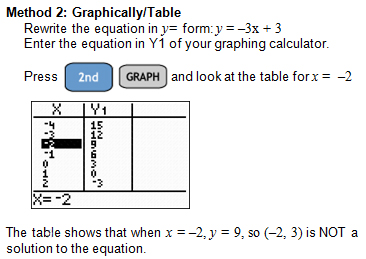Method 1: Algebraically
Substitute the given values for x and y into the equation.
3x + y = 3
3(-2) + 3 = 3
-6 + 3 ≠ 3
-3 ≠ 3
Since the equation is false, we know that (-2, 3) is NOT a a solution to the equation.

In certain instances you are asked to determine if a certain point is a solution to a particular linear equation.
For example: Is (-2, 3) a solution to the equation 3x + y = 3?
There are two different ways to determine if the given point is a solution to the given equation.
Method 1: Algebraically
Substitute the given values for x and y into the equation.
3x + y = 3
3(-2) + 3 = 3
-6 + 3 ≠ 3
-3 ≠ 3
Since the equation is false, we know that (-2, 3) is NOT a a solution to the equation.

Practice: Use the graphing calculator link below to determine if the given points are solutions to the given equations. Write the answers on your own paper.

On your own paper, determine if the given point is a solution to the given equation algebraically.
